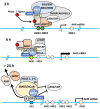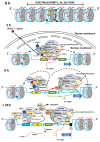New insights into coordinated regulation of AHR promoter transcription; molecular mechanisms and therapeutic targets
- PMID: 40765830
- PMCID: PMC12320239
- DOI: 10.7150/ijbs.112869
New insights into coordinated regulation of AHR promoter transcription; molecular mechanisms and therapeutic targets
Abstract
The aryl hydrocarbon receptor (AHR) plays crucial roles in the control of stress, xenobiotic metabolism, inflammation, and cancer. However, information on the chromatin regulation of ligand-dependent AHR promoter activation is limited. AHR and nuclear factor erythroid 2-related factor 2 (NRF2) signaling are coordinated to maintain the balance of reactive oxygen species (ROS), which is termed the AHR-NRF2 gene battery. Recently, promoter activation of AHR to phase I ligands was reported to be regulated by AHR-NRF2-Jun dimerization protein 2 (JDP2) in a spatiotemporal manner. Tight coupling between phase I and II nuclear transcriptional factor complexes through histone chaperone JDP2 in a time- and space-dependent manner may occur in the chromatin to regulate phase I gene expression. This new mechanism, termed AHR-NRF2-JDP2 gene battery, may facilitate the identification of therapeutics at the reduction of reactive toxic intermediates at the nucleosome level. Identifying the AHR-NRF2-JDP2 gene battery mechanisms will enable the development of novel therapeutics for the risk assessment of oxidative stress/antioxidation, detoxification, ROS, cell death, inflammation, allergies, and cancer.
Keywords: Jun dimerization protein; aryl hydrocarbon receptor; chromatin control; nuclear factor erythroid 2-related factor 2; reactive oxygen species; transcriptional regulation.
© The author(s).
Conflict of interest statement
Competing Interests: The authors have declared that no competing interest exists.
Figures



References
-
- Poland A, Glover E, Kende AS. Stereospecific, high affinity binding of 2,3,7,8-tetrachlorodibenzo-p-dioxin by hepatic cytosol. Evidence that the binding species is receptor for induction of aryl hydrocarbon hydroxylase. J Biol Chem. 1976;251:4936–46. - PubMed
-
- Nebert DW. The Ah locus. A gene with possible importance in cancer predictability. Arch Toxicol Suppl. 1980;3:195–207. - PubMed
-
- Poland AP, Glover E, Robinson JR, Nebert DW. Genetic expression of aryl hydrocarbon hydroxylase activity. Induction of monooxygenase activities and cytochrome P1-450 formation by 2,3,7,8-tetrachlorodibenzo-p-dioxin in mice genetically "nonresponsive" to other aromatic hydrocarbons. J Biol Chem. 1974;249:5599–606. - PubMed
-
- Sahebnasagh A, Hashemi J, Khoshi A, Saghafi F, Avan R, Faramarzi F. et al. Aromatic hydrocarbon receptors in mitochondrial biogenesis and function. Mitochondrion. 2021;61:85–101. - PubMed
Publication types
MeSH terms
Substances
LinkOut - more resources
Full Text Sources
Miscellaneous

